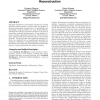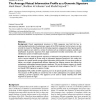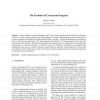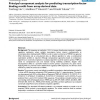112 search results - page 17 / 23 » An analysis of island models in evolutionary computation |
GECCO
2006
Springer
13 years 11 months ago
2006
Springer
This paper introduces a novel analogy with the way in which honeybee colonies operate in order to solve the problem of sparse and quasi dense reconstruction. To successfully solve...
BMCBI
2008
13 years 7 months ago
2008
Background: Occult organizational structures in DNA sequences may hold the key to understanding functional and evolutionary aspects of the DNA molecule. Such structures can also p...
TNN
2010
13 years 2 months ago
2010
Soft computing (SC) emerged as an integrating framework for a number of techniques that could complement one another quite well (artificial neural networks, fuzzy systems, evolutio...
APIN
1998
13 years 7 months ago
1998
Process algebra are formal languages used for the rigorous specification and analysis of concurrent systems. By using a process algebra as the target language of a genetic program...
BMCBI
2005
13 years 7 months ago
2005
Background: The responses to interleukin 1 (IL-1) in human chondrocytes constitute a complex regulatory mechanism, where multiple transcription factors interact combinatorially to...




